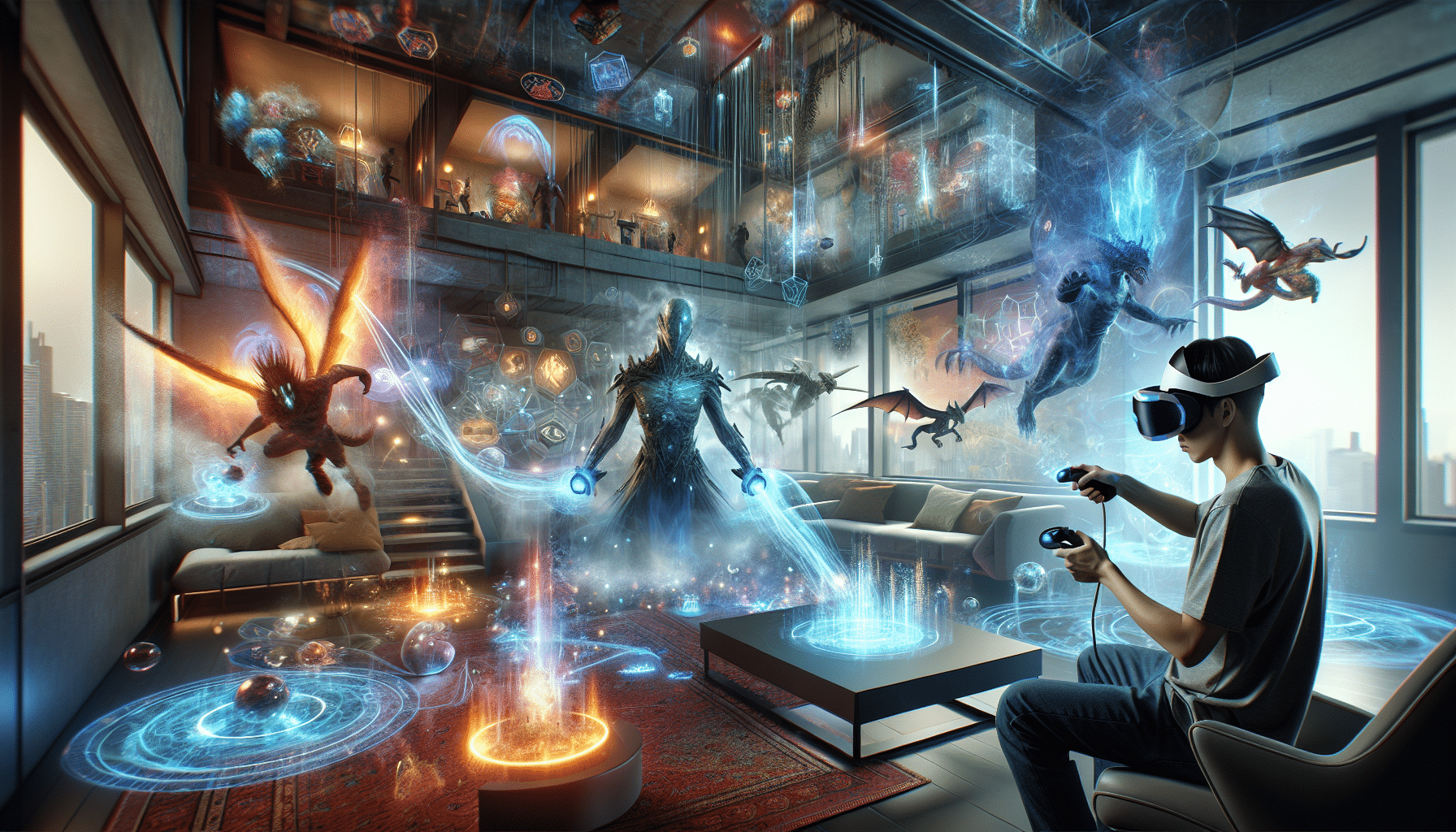Adverts
Total immersion in gaming is about to reach a new level with advances in Virtual Reality (VR) and Augmented Reality (AR). These technologies are not only transforming the way players interact with virtual worlds, but also opening the door to more immersive and interactive experiences. This article explores how the combination of VR and AR is redefining the gaming landscape, allowing players to become an active part of the stories and challenges presented.
Adverts
The event will cover the key developments that have driven the adoption of these technologies, from the most innovative devices to the practical applications that are shaping the industry. In addition, the analysis will include the social and cultural impact that this new era of gaming brings, from the possibility of richer social interactions to the emergence of new forms of entertainment and competition.
Finally, future trends will be discussed, offering insight into how total immersion may evolve and what new experiences can be expected. With a comprehensive and thought-provoking vision, this content aims to spark curiosity about what’s to come in this fascinating gaming universe. 🎮✨
Adverts
The Current Virtual and Augmented Reality Landscape
Virtual Reality (VR) and Augmented Reality (AR) have made significant strides in recent years, shaping the future of gaming and creating immersive experiences that once seemed unattainable. These technologies are now used not only for entertainment, but also in areas such as education, healthcare and professional training. VR offers a fully immersive experience, allowing players to step into virtual worlds, while AR overlays digital information on the real world, creating a unique interaction.
- Virtual Reality: total immersion in digital worlds.
- Augmented Reality: superimposition of virtual elements on the real world.
- Popular devices: Oculus Rift, HTC Vive, Microsoft HoloLens.
- Applications: games, education, health, training.
Through these technologies, developers are creating richer, more interactive experiences. For example, action-adventure games are benefiting greatly from VR, allowing players to feel like they are truly part of the narrative. AR, in turn, has revolutionized location-based games like Pokémon GO, where players interact with virtual creatures that appear in the real world.
Virtual Reality Game Development
VR game development requires a different approach compared to traditional games. The narrative, gameplay mechanics, and visual design need to be adapted to deliver an immersive and intuitive experience. Design considerations include:
1. Control and Interaction
Control methods in VR games are essential to the player experience. Instead of using a keyboard and mouse, players often use motion controllers, allowing for more natural interactions. This includes gestures, body movements, and even haptic feedback. Design should consider ergonomics and ease of use, as discomfort can detract from immersion.
2. Level Design
Creating virtual worlds requires a new approach to level design. Developers need to ensure that environments are both explorable and intuitive. This involves:
- Creation of spaces that encourage exploration.
- Consideration of the scale and proportion of objects.
- Implementation of visual cues to guide players.
Understanding the player’s perspective is key to creating a sense of presence. Well-designed environments allow players to feel truly part of the virtual world.
3. Narrative and Immersion
Storytelling in VR games should be engaging and interactive. The player’s ability to make decisions that affect the outcome of the story is a crucial aspect. This can include:
- Dialogue choices that influence characters.
- Decisions that affect story progression.
- Dynamic events based on player actions.
Developers must work closely with writers to ensure the narrative flows naturally within the virtual environment, providing a sense of urgency and engagement.
Augmented Reality and Its Applications in Games
Augmented Reality (AR) differentiates itself from VR by adding digital layers to the real world, providing interactive experiences that can be played anywhere. This technology is already being used in innovative ways in gaming and could transform the way players interact with their environments.
1. Interaction with the Real World
AR allows players to interact with virtual elements in their own environments. This creates a sense of continuity between the physical and digital worlds. Games that use AR often encourage players to physically move around, exploring different locations and interacting with objects in their surroundings.
2. Examples of Augmented Reality Games
GameDescriptionPlatformPokémon GOCatch Pokémon in real-world locations.Android, iOSIngressLocation-based strategy game.Android, iOSHarry Potter: Wizards UniteExplore and capture magical creatures.Android, iOS
These games not only provide entertainment, but also encourage physical activity and socialization among players, promoting a more active lifestyle.
Future Trends in the Gaming Industry
As technology advances, new trends are emerging that will shape the future of VR and AR gaming. These include:
1. Hybrid Reality
The combination of VR and AR, known as Hybrid Reality, is gaining traction. This approach allows developers to create experiences that blend virtual elements with the real world in a more seamless way. Imagine an adventure game where players can don a VR headset to explore a digital world while interacting with real-world objects.
2. Improvements in Hardware Technology
Continued advancements in VR and AR hardware, such as lighter devices with higher resolution and reduced latency, will enable more immersive experiences. The evolution of neural interfaces could also revolutionize the way we interact with games, allowing players to control actions through their thoughts.
3. Accessibility and Inclusion
As technologies become more accessible, more people are expected to experience VR and AR games. Developers are focusing on creating games that are inclusive, catering to different abilities and needs. This may include accessibility modes that allow players with physical or sensory disabilities to fully participate.
Challenges and Ethical Considerations
As VR and AR technologies grow, so do ethical challenges and questions. It’s crucial that the industry addresses these issues to ensure a positive and safe experience for players.
1. Security and Privacy
Data collection in AR games can raise privacy concerns. Many games rely on location information, which can put players at risk if proper precautions are not taken. It is essential that developers implement transparent privacy policies and security measures to protect user information.
2. Psychological Effects
Deep immersion in virtual environments can have psychological effects on players. Disconnection from reality, gaming addiction, and desensitization to violence are valid concerns that need to be addressed. Developers should be aware of the potential consequences of their creations and promote healthy gaming practices.
3. Digital Inclusion
While technology is becoming more accessible, there are still barriers that can limit participation for certain groups. Access to VR and AR devices can be restricted by economic or geographic factors. It is critical that the industry works to democratize access to these technologies, ensuring that everyone has the opportunity to participate.
The Role of Community and Developers
Interaction between the gaming community and developers is vital to the success and evolution of VR and AR games. User feedback can guide improvements and innovations, making experiences more satisfying and engaging.
1. Collaboration and Co-creation
Developers are increasingly seeking collaboration with the gaming community. This can happen through beta testing, where players provide feedback on features and gameplay mechanics before the official release. This approach helps identify bugs and improve the user experience.
2. Content Sharing and Modding
The ability to create and share user-generated content is becoming a popular feature in VR and AR games. This allows players to personalize their experiences and share creations with the community, increasing the longevity of games and fostering a sense of ownership.
3. Events and Competitions
In-person events and online competitions have become increasingly popular, bringing together players from all over the world. These interactions provide a platform for the community to connect, compete and share experiences, which is essential for the healthy growth of the industry.

Conclusion
Total immersion represents a significant milestone in the future of gaming, bringing to light the vast possibilities that Virtual Reality (VR) and Augmented Reality (AR) offer. By combining visual and auditory experiences with interactivity, these technologies are transforming the way we play and connect with virtual worlds. As such, the potential for creating truly captivating experiences is immense, allowing players to feel like they are part of the game rather than just spectators. Furthermore, as technology advances, we can expect the costs of VR and AR devices to decrease, making these experiences accessible to an even wider audience.
Furthermore, the integration of artificial intelligence with VR and AR promises to further personalize and enrich experiences, responding to players’ actions in innovative ways. It is therefore clear that total immersion is not just a passing trend, but rather a revolution that will shape the future of gaming. As we continue to explore these technologies, we must be mindful of their implications and their potential to enrich our lives, both in entertainment and beyond. Ultimately, the era of total immersion is just beginning, and the possibilities are limitless. 🌟




